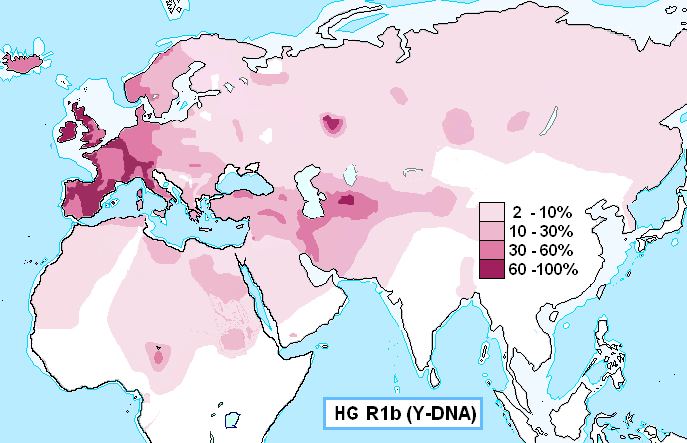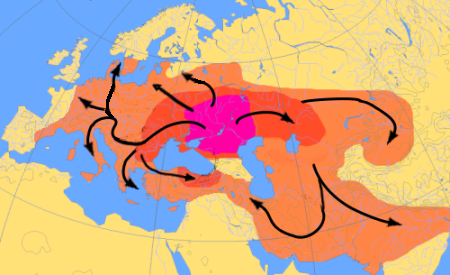
R1b — Gene Of Modern Civilization (And Red Hair)
By Lance Welton
09/07/2019
Above, VDARE.com Editor Peter Brimelow holds up red-headed daughter Victoria Beauregard, representing the future of the R1b gene.

As part of Israeli foundation executive Yoram Hazony’s attempt to steer America’s burgeoning nationalism into politically acceptable (to him) channels, he felt obliged to argue that Judaism in general and Israel in particular are proposition entities i.e. have no ethnic dimension. Of course this is absurd, as I was easily able to demonstrate. But when VDARE.com Editor Peter Brimelow similarly refuted Hazony, he also noted that an ethnic dimension “is not that unusual in long-established nation-states. Some 60% of English men, and 80% of Irish men, carry the R1b haplogroup, as I do myself).” So what about this R1b haplogroup?
Simply put, it is the gene that pretty much defines being Western European. As such, it is the gene of modern civilization.
And, curiously, it’s often also the gene for red hair.
R1b is the Y chromosome haplogroup of between 60 and 100% of the Irish, Welsh, and southern English, as well as in much of France and Spain. For the rest of Western Europe, it’s the paternal line of between 30% and 60% of the population. (And about half of American men are R1-b [Race, Ancestry, and Genetic Composition of the U.S., by Richard Morrill, NewGeography.com, September 23, 2015].

According to genetic analyses of archaeological finds, R1b first made an appearance in Europe — specifically Veneto in Italy — about 14,000 years ago [The genetic history of Ice Age Europe, Q. Fu et al., Nature, 2016] with the original point of origin believed to be somewhere in Western Asia [A major Y-chromosome haplogroup R1b Holocene effect in Central and Western Europe, by N. Myres et al., European Journal of Human Genetics, 2010].

The so-called “Kurgan Hypothesis” advanced by Lithuanian archaeologist Marija Gimbutas (1921-1994) holds that this area of Western Asia was the proto-Indo-European Homeland. Consistent with Gimbutas’ idea, various studies have now shown that R1b spread from Western Asia to Western Europe, and that this also parallels the path of Indo-European languages [Eight thousand years of natural selection in Europe, by I. Mathieson et al., bioRxiv, 2015].

Almost all languages in Europe are Indo-European, as are many West Asian languages, such as Hindi, Persian, Kurdish and Pashto. The European exceptions are the Finno-Ugric languages of Finnish, Estonian and Hungarian and the isolate of Basque. It has been argued that Basque is an “Old European” language, present before either Finno-Ugric peoples or Indo-Europeans arrived [The Basque History of the World, by Mark Kurlansky]. Finno-Ugric languages simply reflect migration of their speakers from the east.
R1b’s presence is extremely high in the far west of Europe and decreases as you move eastwards. This is because R1b in the East has had longer to be diluted by other migrations. It has been argued that R1b spread northwest with the Indo-Europeans, who had originated farming in the Middle East roughly 12,000 years ago and were therefore able to outcompete indigenous hunter-gatherers. This fits with other findings if we remember that the estimates of age for skeletons can only be approximate. Indo-Europeans eventually ended up in Ireland, where they found a natural barrier to any further westward expansion in the form of the Atlantic Ocean [The peopling of Europe, by B. Arredi et al., in M. Crawford, Anthropological Genetics, 2007, p.394].
In line with this, all of the more recent subclades to R1b have developed in Europe.
However, another reason for the extreme dominance of R1b in certain parts of Europe is a combination of “back and forth migration” and mini “revolutions” providing its carriers with further advantages. The innovation of agriculture gave the groups that practiced it a massive advantage, because they could build larger populations and specifically could support people who didn’t have to engage in subsistence agriculture — allowing them to concentrate on developing better weapons, for example. This refining of culture must have led to numerous other “mini-breakthroughs” that gave particular groups, notably those that carried R1b, an edge.
Thus Beaker Culture, named after its signature inverted bell-shaped drinking vessels, showed up in Western Europe roughly 5000 years ago, seemingly displacing the previous “culture” in the British Isles, Germany, the Netherlands, Spain, and northern France — the precise areas where R1b is now the most dominant. In fact, Beaker Culture was so successful that it took R1b to North Africa and to Sardinia, although it never became dominant there.
Nor was this some linear sweep in a particular direction. Archaeological and genetic evidence indicates lots of “back-and-forth migration,” especially between Brittany, Spain and Ireland.
And why do certain countries have so many people with red hair? They simply reflect a specific form of the R1b gene on the Y chromosome. This subclade of R1b appears to explain the rise of the “carrot top” — not, as was once believed, north European intermixture with Neanderthals [Neanderthals didn’t give us red hair but they certainly changed the way we sleep, by Darren Curnoe, The Conversation, October 6, 2017]. (The Bashkirs, a concentration of redheads on the Eastern edge of European Russia, may be an exception).
Red hair is very rare globally, but in so-called Celtic nations, such as Ireland and Scotland, as much as 10% of the population are ginger. Flaming locks are also very noticeable in England (4%) and in Iceland, as well as in parts of Norway and Germany. But only 0.57% of Italians are ginger [Mapped: Which countries have the most redheads?, by Oliver Smith, Telegraph, January 12, 2017]. In fact, the Romans, such as the writer Tacitus, remarked upon the high levels of ginger hair among the Germanics while others documented it among the Celts [Ancient Greece and Rome: Demeter-Law, Roman, by Carroll Moulton, 1998, p.93].
Many Norwegians are blond, but, in the southwest of the country there are a high proportion of gingers. This red-haired prevalence coincides with a higher percentage of Norwegians with the paternal line haplogroup R1b-L21, including its “subclade” R1b-M22, which is usually found in northwest Ireland and in Scotland. The probable reason is that the Vikings took male slaves from Celtic countries and these slaves interbred with the native population.
Even in southern Europe, ginger hair occasionally manifests itself, due to it being a recessive trait and two parents both carrying the recessive gene. However, it has been heavily selected out, as light skin provides an advantage in the dark north — allowing vitamin D to be absorbed from the sun — but can lead to skin cancer in the sunnier south [The genetic causes, ethnic origins and history of red hair, by Maciamo Hay, Eupedia, 2019]
Ginger-haired kids, with their allied pale skin and freckles, are stereotypically bullied at school. South Park’s Eric Cartman refers to them as “Night Walkers” — until he wakes up one morning to find that he has red hair, leading him to morph into a fervent ginger rights activist.
But perhaps Cartman, generally portrayed as the most red-pilled member of the South Park cast, should be fighting for “ginger rights” no matter what the color of his own hair — because of R1b’s role underpinning Western civilization.
Lance Welton is the pen name of a freelance journalist living in New York.
